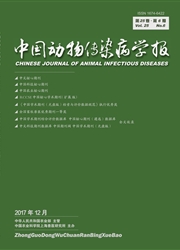

 中文摘要:
中文摘要:
本研究对亚洲璃眼蜱多肽Ha-11的编码基因进行了克隆、表达和初步的功能分析。该基因开放阅读框(open reading frame,ORF)为372 bp,编码123个氨基酸,其中含23个氨基酸的信号肽。将去除信号肽的编码区基因亚克隆至pGEX-4T-1载体,大肠杆菌中诱导表达,获得了37 kDa重组蛋白。抗重组Ha-11蛋白的免疫血清识别半饱血雌蜱的唾液腺中约11 kDa的天然蛋白。Real-time PCR结果表明该基因在亚洲璃眼蜱的各发育阶段、各组织中均有表达,但以若蜱表达量最高,而组织中以淋巴液表达量最高。重组蛋白在体外可以抑制脾细胞增殖和细胞因子IL-2、IFN-γ的分泌。研究结果显示Ha-11在蜱吸血过程中可能具有抗炎作用。
 英文摘要:
英文摘要:
In the present study, we reported cloning, expression and primary biological identification of Ha-11gene from Hyalomma asiaticum. The ORF of Ha-11gene was 372 bp encoding 123 amino acid residues including a signal peptide of 23 amino acid residues. A 37 kDa recombinant protein was obtained from E.coli DH5αusing pGEX-4T-1 as expression. A specific band about 11kDa was detected in the salivary gland of female ticks in Western blot using anti-recombinant Ha-11serum. The result of Real-time PCR indicated that Ha-11 was expressed in all of developmental stages and tissues of adult female ticks with the highest expression in nymphs and hemolymphs. Recombinant Ha-11 protein significantly suppressed the proliferation of spleen cells and secretion of cytokines including IFN-γand IL-2 invivo. The results obtained here suggested that recombinant protein might be involved in suppression of inflammation.
 同期刊论文项目
同期刊论文项目
 同项目期刊论文
同项目期刊论文
 期刊信息
期刊信息
